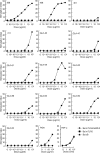Cell activation by monosaccharide lipid A analogues utilizing Toll-like receptor 4
- PMID: 12941142
- PMCID: PMC1783012
- DOI: 10.1046/j.1365-2567.2003.01709.x
Cell activation by monosaccharide lipid A analogues utilizing Toll-like receptor 4
Abstract
Lipid A is the bioactive centre of lipopolysaccharide (LPS), and its properties exhibit various endotoxic and biological effects toward host cells. We examined whether Toll-like receptors (TLRs) are mediated by the signals from various synthetic acylated derivatives of d-glucosamine monophosphate. All test synthetic monosaccharide lipid A analogues similar to acylated beta-(1-6)-d-glucosamine disaccharide bisphosphates, such as Escherichia coli-type lipid A (compound 506) and its precursor (compound 406), clearly induced nuclear factor (NF)-kappaB activation in Ba/F3 cells expressing murine TLR4 and its accessory protein MD-2 (Ba/mTLR4/mMD-2), but no induction was found in those expressing murine TLR2 (Ba/mTLR2). Compound 411, the non-reducing sugar moiety of compound 506, exhibited interleukin-8 (IL-8) and tumour necrosis factor-alpha (TNF-alpha)-producing activities in human peripheral blood mononuclear cells (PBMC), whereas compound 401, the reducing moiety of compounds 506 and 406, and Gifu lipid A-46 (GLA-46), the non-reducing moiety of compound 406, induced no production of IL-8 and TNF-alpha, which was similar to the findings for compound 406. Among the synthetic triacylated monosaccharide lipid A analogues, some compounds with three tetradecanoyl (C14) groups or that included a dodecanoyl (C12) group were more active toward murine and human cells than were other analogues with a decanoyl (C10) or hexadecanoyl (C16) group. Furthermore, IL-8 production in PBMC stimulated with the active monosaccharide lipid A analogues as well as compound 506 was clearly inhibited by the monoclonal antibody to human TLR4. These findings suggest that monosaccharide lipid A analogues similar to disaccharide lipid As are capable of activating both murine and human cells through TLR4.
Figures






Similar articles
-
Osteoclast differentiation by human osteoblastic cell line SaOS-2 primed with bacterial lipid A.FEMS Immunol Med Microbiol. 2003 Aug 18;38(1):71-9. doi: 10.1016/S0928-8244(03)00111-1. FEMS Immunol Med Microbiol. 2003. PMID: 12900058
-
Cell activation by Porphyromonas gingivalis lipid A molecule through Toll-like receptor 4- and myeloid differentiation factor 88-dependent signaling pathway.Int Immunol. 2002 Nov;14(11):1325-32. doi: 10.1093/intimm/dxf097. Int Immunol. 2002. PMID: 12407023
-
Toll-like receptor 4 mediates the antitumor host response induced by a 55-kilodalton protein isolated from Aeginetia indica L., a parasitic plant.Clin Diagn Lab Immunol. 2004 May;11(3):483-95. doi: 10.1128/CDLI.11.3.483-495.2004. Clin Diagn Lab Immunol. 2004. PMID: 15138173 Free PMC article.
-
Reviewing and identifying amino acids of human, murine, canine and equine TLR4 / MD-2 receptor complexes conferring endotoxic innate immunity activation by LPS/lipid A, or antagonistic effects by Eritoran, in contrast to species-dependent modulation by lipid IVa.Comput Struct Biotechnol J. 2013 Apr 5;5:e201302012. doi: 10.5936/csbj.201302012. eCollection 2013. Comput Struct Biotechnol J. 2013. PMID: 24688705 Free PMC article. Review.
-
Fundamentals of endotoxin structure and function.Contrib Microbiol. 2005;12:1-27. doi: 10.1159/000081687. Contrib Microbiol. 2005. PMID: 15496774 Review. No abstract available.
Cited by
-
Immunopharmacology of lipid A mimetics.Adv Pharmacol. 2013;66:81-128. doi: 10.1016/B978-0-12-404717-4.00003-2. Adv Pharmacol. 2013. PMID: 23433456 Free PMC article. Review.
-
Novel carboxylate-based glycolipids: TLR4 antagonism, MD-2 binding and self-assembly properties.Sci Rep. 2019 Jan 29;9(1):919. doi: 10.1038/s41598-018-37421-w. Sci Rep. 2019. PMID: 30696900 Free PMC article.
-
NK cells of the oldest seniors represent constant and resistant to stimulation high expression of cellular protective proteins SIRT1 and HSP70.Immun Ageing. 2018 Mar 6;15:12. doi: 10.1186/s12979-018-0115-x. eCollection 2018. Immun Ageing. 2018. PMID: 29541147 Free PMC article.
-
Lipopolysaccharide induces IFN-γ production in human NK cells.Front Immunol. 2013 Jan 28;4:11. doi: 10.3389/fimmu.2013.00011. eCollection 2013. Front Immunol. 2013. PMID: 23372571 Free PMC article.
-
Co-administration of Antimicrobial Peptides Enhances Toll-like Receptor 4 Antagonist Activity of a Synthetic Glycolipid.ChemMedChem. 2018 Feb 6;13(3):280-287. doi: 10.1002/cmdc.201700694. Epub 2018 Jan 24. ChemMedChem. 2018. PMID: 29265636 Free PMC article.
References
-
- Westphal O, Lüderitz O, Galanos C, Mayer H, Rietschel ET. The story of bacterial endotoxin. Adv Immunopharmacol. 1986;3:13–34.
-
- Morrison DC, Ryan JL. Bacterial endotoxins and host immune responses. Adv Immunol. 1979;28:293–450. - PubMed
-
- Rietschel ET, Kirikae T, Schade FU, et al. Bacterial endotoxin: molecular relationships of structure to activity and function. FASEB J. 1994;8:217–25. - PubMed
-
- Severinson E, Larsson EL. Lymphocyte responses to polyclonal T and B cell activators. In: Weir DM, editor. Handbook of Experimental Immunology. Oxford: Blackwell Scientific Publications; 1986. pp. 63.1–63.18.
Publication types
MeSH terms
Substances
LinkOut - more resources
Full Text Sources
Other Literature Sources
Research Materials
Miscellaneous

